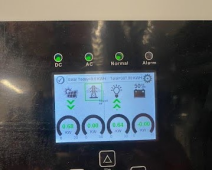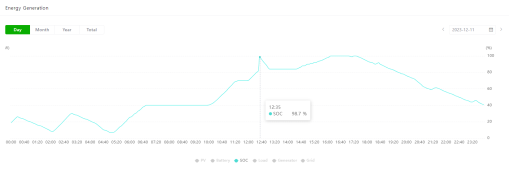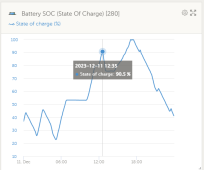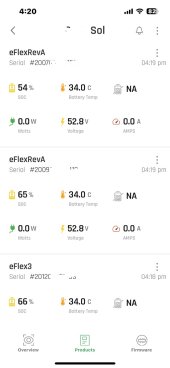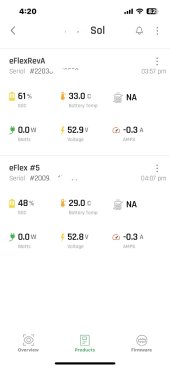Sol-Ark's SOC tracking algorithm runs off and jumps around! And so far I have gotten no satisfactory response from them on any solution!
The scenario is that we have quite a few Sol-Ark's out there with LifePo4 batteries that have no closed loop comms, but with shunt based SOC screen built-into the battery. (Ark battery brand) The Sol-Ark inverters are terrible on tracking the SOC!!! We see them often being off by 50% or more, and the SOC will jump as much as 50-70% at the drop of a hat!
I have worked with battery monitors from Schneider, Magnum, Midnite, Outback, Tri-metric, Victron, etc., etc......... And Sol-Ark is the worst, by far!
It is extremely disappointing that they are not better, when their spec sheet even says they have a shunt "for Accurate % SOC".
Where we really run into issues is on the (quite a few actually) jobs that we are using Time-Of-Use settings to do Limited to Home with no grid sell. When you go SOC based, there are issues where the Sol-Ark says SOC is 50% and the batteries are actually at 15%.... or 5%.... or even completely dead.... I'm talking 49-50V on 16s LFP batteries. Then when the voltage hits the battery empty volts setting, (49V is where we generally have it set) the SOC snaps to 0%.
If we are using the gen start relay this obviously creates issues if we want to start the gen at say, 15% when grid is down, but the Sol-Ark thinks SOC is still at 50% until the batteries are flat dead! There is a huge risk of the system shutting down or even the BMS's shutting down in this scenario. We have one customer who goes to Florida over winter, and he wants to be able to not worry about the system while he is gone, and of course with this issue you can't really actually depend on the backup generator to for sure start in time.
Switching to voltage based is not a viable option, as the Sol-Ark uses the Time-Of-Use setpoint to limit gen charging as well......
So for reference: Using voltage based settings, TOU set to 52V, gen start set to 50.7V (roughly 15%). Now when grid happens to be down for a few days and the battery volts hits 50.7V and we begin to charge at 175A (using Kohler 14KW standby gen), how long until our 300-500AH battery bank hits 52V????? 30 minutes..??? How many times would the gen start in 24hrs? Many times!
Sol-Ark says "use a battery with closed loop comm". Why? Why do they say they have SOC monitoring, when in fact, it doesn't work? Why do we need to come up with work-arounds to overcome the shortcomings of an inverter not having what it is advertised to have?
I emailed them about this issue as well as some others and they at first said they need a few days to look over the issues. Then I got no response and finally after 4 weeks I emailed them and told them I need answers! Now they emailed me back and here is the response:
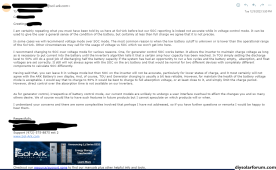
Here is my original email:
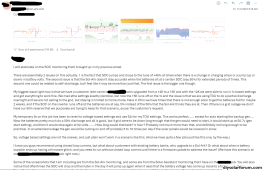

The spec sheet for the 15K says they have a shunt "for Accurate % SOC". I would not say that showing 50% when batteries are at 25% is anywhere near to "accurate"! Neither is it an acceptable margin of error. That is what we saw yesterday on our one job. (Actually the customer sent me these pics wondering if this is right or how it should be.... How do I respond to that...??)


This battery's screen is actually shunt based, and these screens have always been very accurate! Obviously any SOC monitoring device can, and will, sometimes run off! But in the grand scope of things, these have actually done better than any battery monitor from any inverter manufacturer that I have ever worked with. So as you can see, the Sol-Ark isn't even remotely close.....
As far as the jumping around of the SOC on the Sol-Ark goes, here are some screenshots showing that:


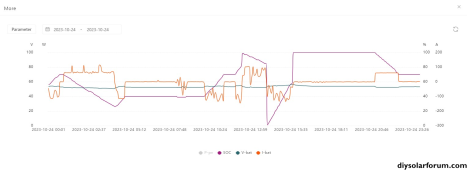

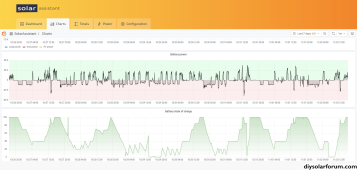
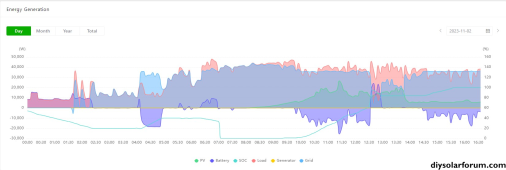



Some of these screenshots are from PowerView, others are from a Solar Assistant that is on our one job, so all of that data would have been directly collected in realtime from the 3x Sol-Arks that are on that job.
I really wish this post would somehow get the attention of Sol-Ark, and they would work on this. But at this point my faith in that is pretty small...
The Sol-Ark inverter can't be beat in terms of simplicity and also they just have an absolutely great all-in-one platform! That is why we use a ton of these units! And compared to other brands they rule in areas like stringing solar panels (26A pr mppt, why doesn't anyone else do that????), 200A passthrough is great and not many others have that, the menu is better than pretty much any other all-in-one (although it is way behind when compared to non all-in-one setups like Schneider, Victron, etc., etc., etc.), built-in battery breaker, we really like their battery terminals as well, and even their solar wire connectors are hard to beat!
But if I constantly have customers calling with issues that have to do with a problem with the programming of the inverter, I very quickly start feeling like it would be worth it to revert back to a non all-in-one system. A system that we can install and know pretty much with 100% certainty that we can walk away from it, and it'll just work! A system where we can tell the customer "your generator will start before the batteries are dead". A system where we can say, just look at this screen to see what % your battery charge is at.
Sadly, this issue is literally only a software issue! All it would take is some programming, and it could be fixed! But the response is that there won't be a change.....
P.S. For a backdrop, I have been in the solar industry for over 10 years, I have personally installed probably 400+ battery setups, and we as a company have installed 100+ Sol-Arks. So I'm not at all new to this stuff. I have seen things that work, and I have seen things that don't work. I prefer what works! ??️??
??️??
The scenario is that we have quite a few Sol-Ark's out there with LifePo4 batteries that have no closed loop comms, but with shunt based SOC screen built-into the battery. (Ark battery brand) The Sol-Ark inverters are terrible on tracking the SOC!!! We see them often being off by 50% or more, and the SOC will jump as much as 50-70% at the drop of a hat!
I have worked with battery monitors from Schneider, Magnum, Midnite, Outback, Tri-metric, Victron, etc., etc......... And Sol-Ark is the worst, by far!
It is extremely disappointing that they are not better, when their spec sheet even says they have a shunt "for Accurate % SOC".
Where we really run into issues is on the (quite a few actually) jobs that we are using Time-Of-Use settings to do Limited to Home with no grid sell. When you go SOC based, there are issues where the Sol-Ark says SOC is 50% and the batteries are actually at 15%.... or 5%.... or even completely dead.... I'm talking 49-50V on 16s LFP batteries. Then when the voltage hits the battery empty volts setting, (49V is where we generally have it set) the SOC snaps to 0%.
If we are using the gen start relay this obviously creates issues if we want to start the gen at say, 15% when grid is down, but the Sol-Ark thinks SOC is still at 50% until the batteries are flat dead! There is a huge risk of the system shutting down or even the BMS's shutting down in this scenario. We have one customer who goes to Florida over winter, and he wants to be able to not worry about the system while he is gone, and of course with this issue you can't really actually depend on the backup generator to for sure start in time.
Switching to voltage based is not a viable option, as the Sol-Ark uses the Time-Of-Use setpoint to limit gen charging as well......
So for reference: Using voltage based settings, TOU set to 52V, gen start set to 50.7V (roughly 15%). Now when grid happens to be down for a few days and the battery volts hits 50.7V and we begin to charge at 175A (using Kohler 14KW standby gen), how long until our 300-500AH battery bank hits 52V????? 30 minutes..??? How many times would the gen start in 24hrs? Many times!
Sol-Ark says "use a battery with closed loop comm". Why? Why do they say they have SOC monitoring, when in fact, it doesn't work? Why do we need to come up with work-arounds to overcome the shortcomings of an inverter not having what it is advertised to have?
I emailed them about this issue as well as some others and they at first said they need a few days to look over the issues. Then I got no response and finally after 4 weeks I emailed them and told them I need answers! Now they emailed me back and here is the response:

Here is my original email:


The spec sheet for the 15K says they have a shunt "for Accurate % SOC". I would not say that showing 50% when batteries are at 25% is anywhere near to "accurate"! Neither is it an acceptable margin of error. That is what we saw yesterday on our one job. (Actually the customer sent me these pics wondering if this is right or how it should be.... How do I respond to that...??)


This battery's screen is actually shunt based, and these screens have always been very accurate! Obviously any SOC monitoring device can, and will, sometimes run off! But in the grand scope of things, these have actually done better than any battery monitor from any inverter manufacturer that I have ever worked with. So as you can see, the Sol-Ark isn't even remotely close.....
As far as the jumping around of the SOC on the Sol-Ark goes, here are some screenshots showing that:









Some of these screenshots are from PowerView, others are from a Solar Assistant that is on our one job, so all of that data would have been directly collected in realtime from the 3x Sol-Arks that are on that job.
I really wish this post would somehow get the attention of Sol-Ark, and they would work on this. But at this point my faith in that is pretty small...
The Sol-Ark inverter can't be beat in terms of simplicity and also they just have an absolutely great all-in-one platform! That is why we use a ton of these units! And compared to other brands they rule in areas like stringing solar panels (26A pr mppt, why doesn't anyone else do that????), 200A passthrough is great and not many others have that, the menu is better than pretty much any other all-in-one (although it is way behind when compared to non all-in-one setups like Schneider, Victron, etc., etc., etc.), built-in battery breaker, we really like their battery terminals as well, and even their solar wire connectors are hard to beat!
But if I constantly have customers calling with issues that have to do with a problem with the programming of the inverter, I very quickly start feeling like it would be worth it to revert back to a non all-in-one system. A system that we can install and know pretty much with 100% certainty that we can walk away from it, and it'll just work! A system where we can tell the customer "your generator will start before the batteries are dead". A system where we can say, just look at this screen to see what % your battery charge is at.
Sadly, this issue is literally only a software issue! All it would take is some programming, and it could be fixed! But the response is that there won't be a change.....
P.S. For a backdrop, I have been in the solar industry for over 10 years, I have personally installed probably 400+ battery setups, and we as a company have installed 100+ Sol-Arks. So I'm not at all new to this stuff. I have seen things that work, and I have seen things that don't work. I prefer what works!



